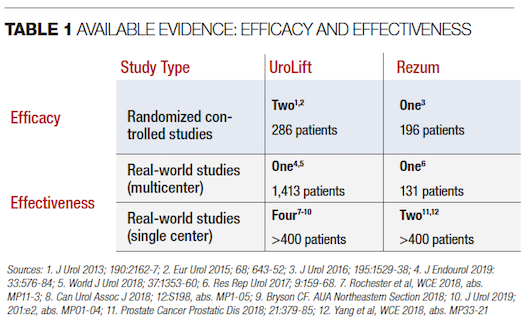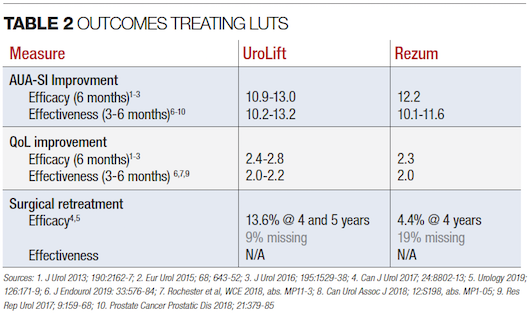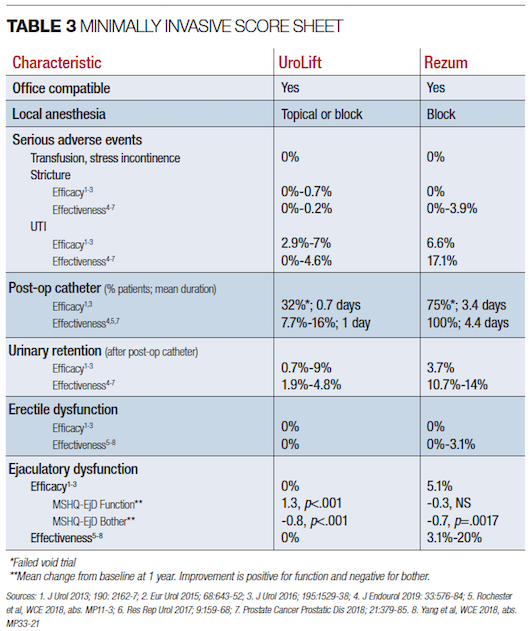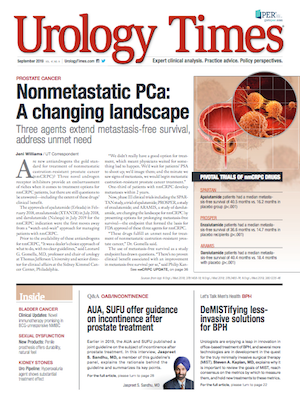Publication
Article
Urology Times Journal
DeMISTifying less-invasive solutions for BPH
Author(s):
"We have entered a renaissance in the care for patients with benign prostatic hyperplasia-related lower urinary tract symptoms," writes Steven A. Kaplan, MD.

Dr. Kaplan is professor of urology at the Icahn School of Medicine at Mount Sinai and director benign urologic diseases, Mount Sinai Health System, New York. Follow him on Twitter at @MaleHealthDoc.
We have entered a renaissance in the care for patients with benign prostatic hyperplasia (BPH)-related lower urinary tract symptoms (LUTS). After 6 decades with our bread-and-butter monopolar transurethral resection of the prostate (TURP) or open prostatectomy, the early ‘90s ushered in pharmaceutical solutions that quickly dominated in uptake. The mid ‘90s and beyond saw the advent of laser fibers and vaporization electrodes for tissue removal, various heat sources for office-based tissue necrosis, and metal urethral stents to mechanically open the prostate, all with the goal of rendering interventional treatment less invasive. While lasers and bipolar electrodes have clearly converted most TURP procedures, the purportedly less invasive stents and tissue necrotic technologies (radiofrequency, microwave, interstitial laser, high-frequency ultrasound) have all but come and gone.
Now, 20 years later, we are enjoying another leap in innovation in office-based treatment of BPH. Tens of thousands of patients have been treated with steam injection, a new form of tissue ablation better known as Rezum, and with a new mechanical solution, the prostatic urethral lift (PUL [UroLift]). Due to their growing uptake, several more technologies are in development in the quest for the truly minimally invasive surgical therapy (MIST). (Other technologies such as Aquablation and plasmakinetic and laser TURPs are not included in this article as they are hospital-based procedures.)
With such a resurgence in activity and with such rich history, it would behoove us as a specialty to review what the goals of MIST are, reach consensus on the appropriate metrics by which to measure them, and hold each new treatment to these metrics.
Why MISTs play important role
If the sole clinical goal in treating BPH was effectively eliminating bladder outlet obstruction, R&D would have concluded decades ago with the description of the suprapubic prostatectomy. No other treatment option has since been shown to more effectively unobstruct a prostate.
However, decades of highly dynamic medical technology and technique developments have occurred, as they have focused primarily on reducing morbidity associated with reducing obstruction. In 1926, Stern and McCarthy performed the first “minimally invasive alternative” to open surgery, transurethral resection of the prostate using the first direct-vision resectoscope. Now, 93 years later, nearly every manuscript published on BPH still asserts that TURP is the “gold standard.” Interestingly and ironically, our patients often do not agree.
Read: New online men’s health sites divide opinion
Of the 12.4 million men in the U.S. with moderate to severe BPH, less than 2% choose TURP as their treatment of choice and only an additional 1% choose any of the interventional alternatives to TURP. While TURP may be the gold standard for reducing bladder outlet obstruction, to our patients and ideally to us, TURP is clearly not the gold standard for net health outcome-the balance of efficacy, morbidity, and patient experience. To better serve the majority of our patients needing treatment for BPH-related LUTS, we must pay close attention to the reasons men avoid TURP and measure alternative treatment options carefully in their ability to avoid these issues.
By sheer uptake it would appear that the BPH “gold standard” to our patients is chronic medication, as approximately 77% of our patients fill prescriptions for a selective alpha-blocker and/or 5-alpha-reductase inhibitor. Numerous large-scale studies, however, have shown that pharmaceuticals have only a modest effect on LUTS and can be associated with unwanted side effects, such as erectile and ejaculatory dysfunction, loss of libido, weakness, fatigue, blurred vision, dizziness, and nasal congestion.
Also important, after 20 years since the launch of finasteride and tamsulosin, are the increasing reports of potential long-term effects such as depression, self-harm, complications in cataract surgery, and possibly increased propensity for stroke or dementia (JAMA Intern Med 2017; 177:683-91; CMAJ 2016; 188:255-60). For these reasons, population studies show that over 60% of our patients are not compliant in taking BPH medication (Eur Urol 2015; 68:418-25). It would appear that medications are less of a gold standard to our patients than a hopeful means to avoid surgery. With millions of men noncompliant or discontinuing medications yet clearly not electing surgery, a very significant number of our patients are seeking an alternative, MIST.
Next: What must MIST do to succeed?What must MIST do to succeed?
The truly minimally invasive interventional answer to BPH would be a treatment option that most of our clearly dissatisfied patients will actually choose and thus improve their lives and avoid further bladder damage. It should be a procedure that we can reliably perform with predictable results, adequate effective reduction of bladder outlet obstruction, and acceptable durability.
But these are already true of our surgical options. MIST, to address those avoiding surgery, must have additional attributes. The MIST score sheet includes:
- offers acceptable relief from LUTS: Symptoms and quality of life improve; generally durable for 5+ years
- is not associated with serious harms of surgery: transfusion, stress or total urinary incontinence, stricture and bladder neck contracture, erectile dysfunction, ejaculatory dysfunction
- can be delivered in the office setting (tolerable under local anesthesia)
- allows for rapid recovery and symptom relief (no postoperative catheter and return to work and full preoperative activity within days).
What are the appropriate MIST metrics?
Historically, the urology community has focused on validated instruments to measure efficacy, namely the AUA Symptom Index (AUA-SI), aka International Prostate Symptom Score, along with the single LUTS-specific quality of life question. We have determined the minimal clinically important difference, the smallest change in AUA-SI that a patient perceives, is about 3 points (J Urol 1995; 154:1770-4). Objectively, we measure peak flow rate (Qmax) and postvoid residual (PVR), but neither reliably correlates with symptom improvement post treatment.
Since the focus of MIST is to not only deliver on efficacy but also greatly reduce morbidity and render a more attractive overall patient experience, it is important that we focus on consistent measures and reporting of adverse effects to understand how BPH options differ. Adverse effects must be chronicled as reported event rates. Since their incidence is ideally low, it is particularly important to report the low percentages. For more prevalent adverse effects, it is also beneficial to report validated instrument means.
Sexual dysfunction
Because sexual dysfunction and BPH are independent predictors of each other, it is also important that studies conduct a substantive baseline evaluation before treatment. Results have varied greatly across BPH studies, showing that TURP hurt, helped, or had no effect on erectile function. The LIFT study of PUL was the first to report sexual dysfunction in a new light: de novo, sustained dysfunction. This was defined as dysfunction occurring within 3 months of treatment (and thus assignable to the treatment) and sustained at 12 months, ruling out transient events. For PUL these rates for ED and EjD were in fact 0%, which indeed sets a gold standard on sexual function preservation.
Interestingly, when PUL was randomized to TURP, TURP also showed 0% de novo, sustained ED, but TURP did show 40% anejaculation (Eur Urol 2015; 68:643-52). Perhaps the lower-than-expected ejaculatory dysfunction was due to rigorous baseline data or perhaps the stringent criteria for de novo, sustained dysfunction.
Catheterization
Patients are also concerned with the need for postoperative catheterization. Historically, MISTs have overpromised and underdelivered on this criterion. Catheters were commonly placed and remained for days or even weeks following treatment with tissue necrotic technologies. It is important in clinical studies to test the need for catheter by conducting void trials. It is also important to accurately report the percent of patients requiring a catheter and the duration in terms of both means and ranges. Retention rates and catheter rates can be conflated and must both be reported.
One could propose “catheter rate,” which chronicles what percent require a catheter initiated within 1 week of treatment. Thereafter, if the patient continues to require a catheter, he contributes not only to the catheter rate and associated catheter duration calculation, but also to the retention rate. For example, if a patient is catheterized within a week, then successfully completes void trials and then goes into retention within 3 days, he should be included in the “catheter rate” and “retention rate,” and his total days on catheter be used in the mean duration calculations.
Next: Efficacy vs. effectivenessEfficacy vs. effectiveness
We all know that double-blinded, randomized, controlled trials (RCTs) are the least biased and most reliable way to determine the efficacy of a treatment. However, we also know from experience that RCT results do not always represent outcomes in real practice. It is important that we examine and report not just the efficacy of a treatment but also the effectiveness.
The pioneer epidemiologist Archie Cochrane defined these types of evidence as follows: Efficacy is the extent to which an intervention does more good than harm under ideal circumstances; ie, Can it work? Effectiveness assesses whether an intervention does more good than harm under usual circumstances of health care practice; ie, Does it work in the real world?

Retreatment rates are carefully tracked in efficacy studies, but BPH studies typically suffer from a significant number of patients lost to follow-up. The 10-year retreatment rates typically quoted for TURP were not derived from prospectively enrolled studies but from retrospective health system databases. Four to five years from now, a retrospective look at the Medicare database, for instance, will be our first opportunity to truly see if these retreatment rates hold up in the uncontrolled setting.
How do today’s MISTs stack up?
Today we have available two new MIST treatments with excellent efficacy data and a growing level of effectiveness evidence (table 1). Both treatments consider the failures of the MIST of the ‘90s and attempt to address them in different directions.

The Rezum steam injection treatment is based on the assumption that thermal ablation works but needs to be delivered more efficiently. Because steam is rapidly dispersed in tissue and also rapidly heats as it condenses, it is far more efficient at inducing tissue necrosis. The steam injection procedure entails on average five injections at 9 seconds each, which compares favorably to the 20 to 60 minutes required for TUNA and TUMT (J Urol 2016; 195:1529-38).
The UroLift is based on the assumption that only mechanical opening of the prostate results in rapid recovery and relief, avoidance of a catheter, and reliable preservation of sexual function. Unlike stents, when PUL implants are properly placed in the prostate lobe, encrustation and migration are unlikely. Because PUL does not rely on necrosis and tissue reabsorption, it is rapid acting and typically does not require postoperative catheterization (Can J Urol 2014; 21:7094-101).
Both MIST treatments have been carefully studied for efficacy, showing similar outcomes of approximately 10-point improvement in AUA-SI and over two-point improvement in QoL (table 2). These outcomes were largely sustained at 4 and 5 years. Surgical retreatment for recurring LUTS has been reported at 13.6% for UroLift at 4 and 5 years and 4.4% for Rezum at 4 years. While it appears that Rezum may be more durable, this must be viewed with caution as 19% patients were no longer in the study versus 9% for UroLift.
Also see: What urologists can do to educate male patients
To compare how close these treatments come to our MIST goals, we can perhaps use a minimally invasive score sheet (table 3). Importantly, the data are presented separately for randomized efficacy trials and real-world effectiveness studies. It should be noted that effectiveness data for UroLift is more extensive and that the majority of the Rezum effectiveness data is derived from single-center studies. Both procedures are routinely performed in the office as well as in facilities depending on practice patterns and reimbursement variations.

Rezum appears to require modestly greater anesthesia in form of prostate block or IV sedation, whereas UroLift is routinely conducted with topical lidocaine. Both procedures avoid the important serious adverse events associated with BPH surgery. Efficacy results showed similar stability or improvement in mean sexual function scores, although only UroLift showed no evidence of de novo, sustained ejaculatory dysfunction.
The early effectiveness data appear to indicate an elevated infection rate with Rezum. This is possibly associated with the now more consistent use of postoperative catheter and/or temporary stent. UroLift, on the other hand, appears to be maintaining a low rate and duration of catheterization and UTI. Early UroLift efficacy studies reported 10% of patients required a misdeployed implant removed, whereas a recent effectiveness study of 1,413 patients showed this to be reduced to less than 1%. UroLift continues to show no de novo, sustained ejaculatory dysfunction, while a low rate of EjD appears persistent with Rezum.
One outlier study reported a 20% rate of anejaculation/retrograde ejaculation after Rezum (Yang et al, WCE 2018 [abstract UP3-33]). The investigators hypothesized that they are perhaps more aggressive in treating the central zone and bladder neck area. All effectiveness studies have been relatively short term, and real-world retreatment rates will only become available once health care system databases are populated over the coming years.
From 1999 to 2005, the number of MIST procedures rose from 11,582 to 72,887, increasing the total number of U.S. BPH procedures 44% (J Urol 2008; 180:241-5). This rate later plummeted due to a disappointment with outcomes and reduced reimbursement. The marked increase in total procedures during the MIST heyday, however, indicated that large numbers of patients were looking for a solution between drugs and surgery.
Today, two new MIST procedures are becoming even more widely used than prior MISTs. There are important differences between these treatment options, and time will tell how well they meet patients’ needs. Rather than be jaded by past attempts, the urologic community should be optimistic that more patients will find the solution they seek to improve their quality of life with reduced morbidity.

Newsletter
Stay current with the latest urology news and practice-changing insights — sign up now for the essential updates every urologist needs.

























